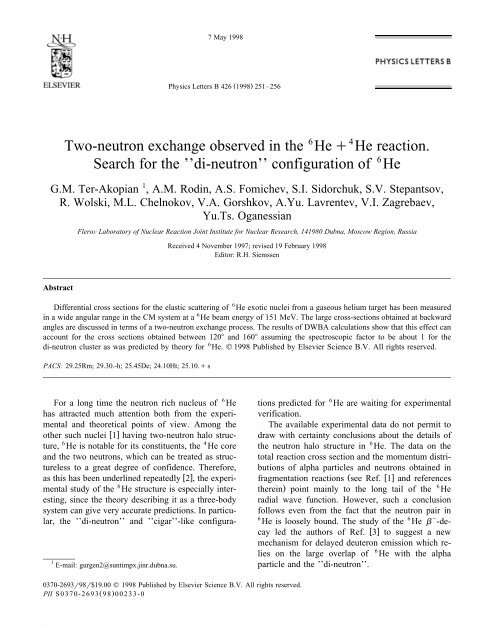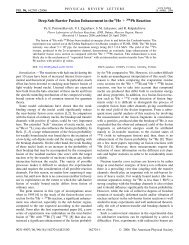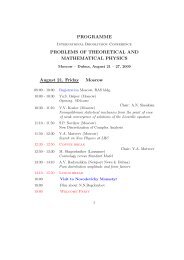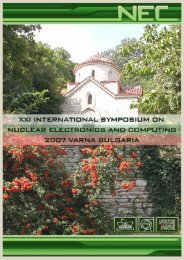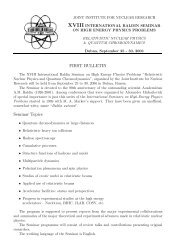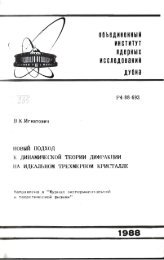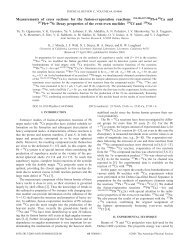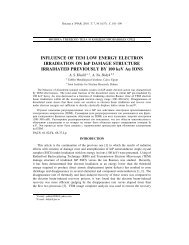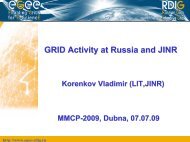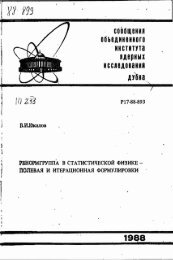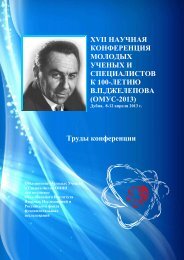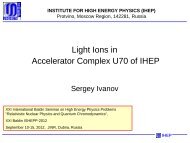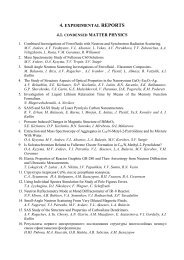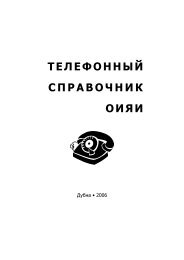di-neutron - Nrv Jinr
di-neutron - Nrv Jinr
di-neutron - Nrv Jinr
You also want an ePaper? Increase the reach of your titles
YUMPU automatically turns print PDFs into web optimized ePapers that Google loves.
7 May 1998<br />
Ž .<br />
Physics Letters B 426 1998 251–256<br />
Two-<strong>neutron</strong> exchange observed in the 6 Heq 4 He reaction.<br />
Search for the ’’<strong>di</strong>-<strong>neutron</strong>’’ configuration of 6 He<br />
G.M. Ter-Akopian 1 , A.M. Ro<strong>di</strong>n, A.S. Fomichev, S.I. Sidorchuk, S.V. Stepantsov,<br />
R. Wolski, M.L. Chelnokov, V.A. Gorshkov, A.Yu. Lavrentev, V.I. Zagrebaev,<br />
Yu.Ts. Oganessian<br />
FleroÕ Laboratory of Nuclear Reaction Joint Institute for Nuclear Research, 141980 Dubna, Moscow Region, Russia<br />
Received 4 November 1997; revised 19 February 1998<br />
E<strong>di</strong>tor: R.H. Siemssen<br />
Abstract<br />
Differential cross sections for the elastic scattering of 6 He exotic nuclei from a gaseous helium target has been measured<br />
in a wide angular range in the CM system at a 6 He beam energy of 151 MeV. The large cross-sections obtained at backward<br />
angles are <strong>di</strong>scussed in terms of a two-<strong>neutron</strong> exchange process. The results of DWBA calculations show that this effect can<br />
account for the cross sections obtained between 1208 and 1608 assuming the spectroscopic factor to be about 1 for the<br />
<strong>di</strong>-<strong>neutron</strong> cluster as was pre<strong>di</strong>cted by theory for 6 He. q 1998 Published by Elsevier Science B.V. All rights reserved.<br />
PACS: 29.25Rm; 29.30.-h; 25.45De; 24.10Ht; 25.10.qs<br />
For a long time the <strong>neutron</strong> rich nucleus of 6 He<br />
has attracted much attention both from the experimental<br />
and theoretical points of view. Among the<br />
other such nuclei wx 1 having two-<strong>neutron</strong> halo structure,<br />
6 He is notable for its constituents, the 4 He core<br />
and the two <strong>neutron</strong>s, which can be treated as structureless<br />
to a great degree of confidence. Therefore,<br />
as this has been underlined repeatedly wx 2 , the experimental<br />
study of the 6 He structure is especially interesting,<br />
since the theory describing it as a three-body<br />
system can give very accurate pre<strong>di</strong>ctions. In particular,<br />
the ’’<strong>di</strong>-<strong>neutron</strong>’’ and ’’cigar’’-like configura-<br />
1 E-mail: gurgen2@suntimpx.jinr.dubna.su.<br />
tions pre<strong>di</strong>cted for 6 He are waiting for experimental<br />
verification.<br />
The available experimental data do not permit to<br />
draw with certainty conclusions about the details of<br />
the <strong>neutron</strong> halo structure in 6 He. The data on the<br />
total reaction cross section and the momentum <strong>di</strong>stributions<br />
of alpha particles and <strong>neutron</strong>s obtained in<br />
fragmentation reactions Žsee Ref. wx 1 and references<br />
.<br />
6<br />
therein point mainly to the long tail of the He<br />
ra<strong>di</strong>al wave function. However, such a conclusion<br />
follows even from the fact that the <strong>neutron</strong> pair in<br />
6 He is loosely bound. The study of the 6 He b y -dewx<br />
cay led the authors of Ref. 3 to suggest a new<br />
mechanism for delayed deuteron emission which relies<br />
on the large overlap of 6 He with the alpha<br />
particle and the ’’<strong>di</strong>-<strong>neutron</strong>’’.<br />
0370-2693r98r$19.00 q 1998 Published by Elsevier Science B.V. All rights reserved.<br />
Ž .<br />
PII S0370-2693 98 00233-0
252<br />
( )<br />
G.M. Ter-Akopian et al.rPhysics Letters B 426 1998 251–256<br />
It is well known that transfer reactions provide a<br />
good opportunity to study the structural parameters<br />
and spectroscopic factors of simple nuclear configurations.<br />
Therefore it appears to be natural to use such<br />
reactions for testing the 6 He internal wave function<br />
wx 2 . In the case of collision partners, which could be<br />
6 He and 4 He, this could be two <strong>neutron</strong> transfer, i.e.<br />
an exchange effect which should be observed in the<br />
centre-of-mass frame as elastic scattering in the<br />
backward <strong>di</strong>rection Žsee e.g. Ref. wx. 4 . A helium gas<br />
target is necessary to carry out such a study, and this<br />
makes the problem more complicated from the experimental<br />
point of view. However, such a study<br />
appears to be quite promising as the two-<strong>neutron</strong><br />
exchange occurring between identical core-nuclei<br />
could offer favourable con<strong>di</strong>tions for a detailed test<br />
of the structure of the 6 He nucleus.<br />
The choice of the 6 He projectile energy is essential<br />
for such experiments. In the case of low-energy<br />
collisions Ž up to 15 MeVrnucleon.<br />
potential scattering<br />
will make a sizeable contribution to the elastic<br />
cross section in the whole angular range, i.e. it will<br />
interfere with the searched for exchange effect. For<br />
the collision energy approaching Ž or even excee<strong>di</strong>ng .,<br />
in the CM frame, the Fermi energy in nuclei the<br />
probability of two <strong>neutron</strong> exchange becomes too<br />
small. Thus, for this effect to manifest itself clearly,<br />
the most favourable energy range for the 6 He projectile<br />
makes 20-30 MeVrnucleon. At this energy the<br />
elastic scattering, which is described by the optical<br />
model Ž OM.<br />
potential, will show a steep decrease in<br />
the cross section with increasing angle. Therefore,<br />
the contribution of the potential scattering to the<br />
cross section in the backward <strong>di</strong>rection will be negligible,<br />
and one could observe the exchange effect<br />
without interference from the elastic scattering caused<br />
by the OM potential. An example of such an exchange<br />
reaction is the scattering of 166 MeV 4 He<br />
ions from 6 Li, in which case the backward angle<br />
elastic scattering has been described as the exchange<br />
4<br />
wx<br />
of a deuteron cluster between two He nuclei 5 .<br />
In the present paper we report the results of the<br />
study of the exchange effect in the reaction 6 He q<br />
4 He in which a helium target was bombarded by a<br />
beam of 6 He nuclei. The searched reaction channel<br />
can be uniquely selected by the identification of both<br />
reaction participants. A possible contribution of inelastic<br />
scattering will be absent due to the fact that<br />
all the excited states in both partners, i.e. in 4 He and<br />
6 He, are unstable with respect to the particle emission.<br />
Therefore, the requirement of a high energy<br />
resolution is not essential for this study.<br />
A secondary beam of 6 He was produced by the<br />
fragmentation of a 32 MeVrnucleon 7 Li beam on a<br />
9<br />
Ž 2<br />
.<br />
6<br />
thick Be target 225 mgrcm . The ions of He<br />
were separated using the ACCULINNA facility wx 6<br />
recently commissioned at the U-400M cyclotron.<br />
Some contamination in the separated 6 He beam arising<br />
from 3 H ions was reduced to a level of less than<br />
10% with a 1.3 mm thick aluminium wedge located<br />
in the interme<strong>di</strong>ate focal plane of ACCULINNA.<br />
The momentum acceptance of the spectrometer in<br />
this case was limited to "1.8% by slits with <strong>di</strong>mensions<br />
of 22 and 10 mm in the horizontal and vertical<br />
position, respectively, positioned in the same interme<strong>di</strong>ate<br />
focal plane. The secondary 151 MeV beam<br />
of 6 He ions was finally limited by a system of three<br />
carbon <strong>di</strong>aphragms, which fixed the <strong>di</strong>ameter of the<br />
beam spot on the helium target at ;6.5 mm. The<br />
beam energy spread Ž FWHM.<br />
and transverse emittance<br />
made, respectively, "2% and 30p mmPmrad.<br />
This relatively small transverse beam emittance was<br />
essential for carrying out the experiments without<br />
tracking in<strong>di</strong>vidual bombar<strong>di</strong>ng ions. With this quality,<br />
the 6 He beam intensity amounted up to about<br />
1P10 5 particlesrs at an intensity of the primary 7 Li<br />
beam of 1P10 12 particlesrs.<br />
The helium gas target was enclosed in a cell of a<br />
cylindrical shape with a <strong>di</strong>ameter of 25 mm and a<br />
length of 12 mm. The stainless steel entrance and<br />
exit windows Ž 10 mm each.<br />
had <strong>di</strong>mensions of 24P10<br />
mm 2 in the horizontal and vertical planes, respectively.<br />
The cell was cooled to 78K by liquid nitrogen<br />
and, at a pressure of 5 atm, the resulting thickness of<br />
the 4 He target was equal to 5.6P10 20 atomsrcm 2 .<br />
The experimental setup is shown in Fig. 1. It<br />
consisted of two silicon detector telescopes mounted<br />
on two independently movable arms Žessential parameters<br />
are shown in Fig. 1 for both telescopes ..<br />
The first DE-DE-E telescope was intended for the<br />
low energy 6 He nuclei correspon<strong>di</strong>ng to the backward<br />
angle scattering events. The veto counter E 14<br />
supplemented this telescope. The complementary<br />
high energy 4 He nuclei resulting from the backward<br />
scattering of the 6 He projectiles were detected by the<br />
second DE-DE-E telescope having at its front an
( )<br />
G.M. Ter-Akopian et al.rPhysics Letters B 426 1998 251–256 253<br />
Fig. 1. Scheme of the experimental set up. DE0<br />
stands for the<br />
plastic scintillation detector used for the beam monitoring, DE 21<br />
Ž<br />
2<br />
is an array of position sensitive detectors eight 64P8 mm , 0.3<br />
mm thick Si strips .. Dimensions of other telescope detectors Žthe<br />
two numbers that follow in parentheses the notation of each<br />
detector are, respectively, the detector <strong>di</strong>ameter and thickness,<br />
both in mm .: DE Ž 16, 0.03 ., DE Ž 20, 0.10 ., DE Ž 48, 0.54 .<br />
11 12 13 ,<br />
DE Ž 50, 3.0 ., DE Ž 55, 0.52 ., DE Ž 68, 0.68 ., DE Ž 66, 7.7 ..<br />
14 22 33 24<br />
array of position sensitive Si strips Ždetector DE21<br />
in<br />
Fig. 1.<br />
for measuring the scattering angle. The second<br />
telescope also served for detecting the 6 He<br />
nuclei scattered in the forward <strong>di</strong>rection from the<br />
helium target. The energy resolution of each detector<br />
used in the telescopes was better than 100 keV for<br />
the 5.5 MeV alpha line of 238 Pu. The solid angle of<br />
each of the two telescopes was ;75 msr in the<br />
laboratory system. Both telescopes were placed in a<br />
horizontal plane.<br />
The backward angle elastic scattering cross-section<br />
was extracted from the coincident events when a<br />
6He ion was recorded in the first telescope, and the<br />
correspon<strong>di</strong>ng high-energy 4 He - in the second one.<br />
The forward angle data were obtained from the<br />
single 6 He events in the second telescope. The position<br />
resolution of the strip detector array in the<br />
second telescope was 1 mm and 8 mm FWHM for<br />
the X and Y coor<strong>di</strong>nates, respectively, and therefore<br />
the angle dependent angular resolution was on average<br />
close to "18 Ž in the lab. system .. All together,<br />
the finite target length, beam emittance Žthe beam<br />
size and angular <strong>di</strong>vergence on the target.<br />
and telescope<br />
position resolution led to the errors in the<br />
forward <strong>di</strong>rection CM scattering angle estimations<br />
which <strong>di</strong>d not exceed "38. For the coincident backward<br />
scattering events a better angular resolution<br />
Ž "28 in CM system.<br />
was achieved by taking the<br />
ratio of the energies deposited in the two telescopes.<br />
The 6 He beam was monitored and the total projectile<br />
integral flux was measured by a thin scintillation<br />
detector. It consisted of a 150 mm thick plastic<br />
NE PILOT-U, a hollow light guide made as a cone<br />
from 27 mm Al foil and a R3082 Hamamatsu photomultiplier.<br />
The DE resolution of the detector allowed<br />
one to well separate the 6He projectiles from the 3 H<br />
ions.<br />
Four separate runs were performed, in which the<br />
first telescope detected the reaction products emerging<br />
from the target in the laboratory system within<br />
the angular ranges of 35"9, 35"10, 34"8.4 and<br />
35"10 degrees to which corresponded the angular<br />
ranges of 35"8.5, 16.6"6.3, 20"10 and 10"6.3<br />
degrees covered by the second telescope. The integral<br />
flux amounted to 2.4P10 9 ions of 6 He in total<br />
in the four runs. The data acquisition system was<br />
triggered by the ’’DE OR DE ’’ Ž see Fig. 1.<br />
12 22<br />
con<strong>di</strong>tion in the first run and by the 2 ms coincidence<br />
con<strong>di</strong>tion ’’DE22 AND DE 23’’ in the other<br />
runs.<br />
The DE-E Ž DE versus E .<br />
22 24 energy plot obtained<br />
for the geometry u1s358, u 2s16.68 is shown<br />
Ž.<br />
6<br />
in Fig. 2 a . The loci of the signals from He and<br />
4 He ions are well seen in this plot. It is apparent that<br />
the 4 He events extend to the energy range typical for<br />
the elastic scattering peak of 6 He ions clearly visible<br />
6<br />
in the He branch in Fig. 2Ž. a . The DE-E ŽDE 11<br />
versus DE . plot shown in Fig. 2Ž b.<br />
12<br />
involves the<br />
events detected by the first telescope in coincidence<br />
4<br />
with the He events of the second telescope ŽFig.<br />
2Ž.. a . One can see in Fig. 2Ž. b 6 He events which,<br />
due to their coincidence with the 4 He ions detected<br />
in the second telescope and accor<strong>di</strong>ng to their energy<br />
range, can be identified as the back-scattering of<br />
6 He. The vali<strong>di</strong>ty of this conclusion in relation to the<br />
majority of such events is justified by the examination<br />
of Fig. 3, where the spectrum is shown for the<br />
sum of the energies deposited by the coinci<strong>di</strong>ng 6 He<br />
and 4 He ions in the first and second telescope,<br />
respectively.<br />
In total, 24 6 He- 4 He coincidences were identified<br />
as backward <strong>di</strong>rection elastic scattering events. In<br />
order to estimate the background originating from<br />
the scattering of the 6 He beam ions from the target
254<br />
( )<br />
G.M. Ter-Akopian et al.rPhysics Letters B 426 1998 251–256<br />
Fig. 3. Total kinetic energy spectrum for the 6 He - 4 He coincidences.<br />
The shaded peak corresponds to true events of backscattering.<br />
Fig. 2. Upper panel: Two-<strong>di</strong>mensional plot Ž DE versus DE .<br />
22 24<br />
obtained with the second telescope. Lower panel: DE11<br />
versus<br />
DE12<br />
events observed in telescope 1 in coincidence with the 4 He<br />
Ž<br />
4<br />
events detected in telescope 2 these He events are seen in upper<br />
panel ..<br />
the horizontal bars with downward arrows - for the<br />
upper limits. The obtained absolute cross section<br />
values have error bars "15% which originate from<br />
the uncertainties of the parameters used in Monte<br />
Carlo simulations and errors in the beam monitoring<br />
and target thickness. Only statistical errors are shown<br />
in Fig. 4.<br />
To analyze our experimental results, we first described<br />
by OM the forward angle data. Taking into<br />
windows and beam <strong>di</strong>aphragms, appropriate measurements<br />
were done when the helium was evacuated<br />
from the target cell and when the cell was<br />
removed from the beam axis. The estimated background<br />
for these events was negligible Ž-0.1<br />
.<br />
6<br />
events . In total, about 3,700 He events originating<br />
from the elastic scattering to uCM<br />
s158y558 were<br />
detected in these experiments, and the background<br />
was properly subtracted from these events.<br />
Monte Carlo simulations of the experiment were<br />
performed to estimate the effective solid angles for<br />
all the angular bins. The resulting angular dependence<br />
of the <strong>di</strong>fferential elastic scattering cross section<br />
dsrdV is presented in Fig. 4 : the closed<br />
circles stand for the estimated cross-section values,<br />
Fig. 4. Experimental data Ž symbols.<br />
and theoretical calculation<br />
Ž .<br />
6<br />
Ž .<br />
4<br />
lines for the elastic scattering He 151 MeV q He.
( )<br />
G.M. Ter-Akopian et al.rPhysics Letters B 426 1998 251–256 255<br />
account the quality of these data, we <strong>di</strong>d not try to<br />
precisely fit these by varying the OM parameters.<br />
Instead, we took the OM potential that was found in<br />
wx<br />
4 6<br />
5 for the case of He q Li elastic scattering at<br />
E lab s 166 MeV as a basis. The <strong>di</strong>fferential cross<br />
sections calculated for our 6 He q 4 He system with<br />
this OM potential are shown in Fig. 4 by the dotted<br />
line Ž curve 1 .. The deviation of this calculated curve<br />
from our forward angle experimental points is at<br />
most about 30%. By varying some of the OM potential<br />
parameters within 10% we were able to easily<br />
eliminate this <strong>di</strong>screpancy. Curve 2 in Fig. 4 was<br />
calculated with the following parameters of OM<br />
potential taken in WS-volume form with Rsr 0 P<br />
Ž 1r3 1r3 . Ž .<br />
V<br />
A qA : V sy102.5 MeV 102.5 , r s<br />
P T 0 0<br />
0.522 fm Ž 0.522 ., a s0.920 fm Ž 0.820 .<br />
V , W0s<br />
Ž .<br />
W<br />
y13.0 MeV y11.77 , r s1.130 fm Ž 1.206 .<br />
0 , aW<br />
s0.500 fm Ž 0.950. Žthe numbers given in parenthewx<br />
5 for the<br />
ses are the parameter values used in<br />
6 4<br />
Liq He scattering .. In view of the <strong>di</strong>fference between<br />
6 He and 6 Li, such variations of the OM<br />
parameters are reasonable.<br />
Within the angular range of 1228FuCM<br />
F1558<br />
the calculated elastic scattering cross section varies<br />
between 5P10 y4 and 5P10 y6 mbrsr, whereas the<br />
experimental points lie in this range at a level which<br />
is by 10 2 -10 4 times higher. As was expected, there<br />
is no reasonable set of OM parameters that can<br />
reproduce the yield of the 6 He nuclei observed in the<br />
backward <strong>di</strong>rection. A change in the calculated<br />
dsrdV values by a factor of three to five for some<br />
local angular intervals in the backward hemisphere is<br />
the maximum that one can achieve by varying the<br />
OM parameters. This definitely means that the 6 He<br />
scattering events observed in this angular region are<br />
in fact the result of two-<strong>neutron</strong> exchange. The<br />
authors of Ref. wx 5 came to a similar conclusion<br />
about the role of the deuteron cluster exchange in the<br />
a-particle scattering observed at the backward angles<br />
6<br />
in the reaction LiŽ a,a . 6 Li.<br />
Assuming that the exchange of the two-<strong>neutron</strong><br />
cluster between 6 He and 4 He occurs via a <strong>di</strong>rect<br />
one-step mechanism, one should calculate a 9-<strong>di</strong>mensional<br />
integral consisting of entrance and exit<br />
<strong>di</strong>storted waves and the two-<strong>neutron</strong> wave function<br />
of 6 He to accurately describe the backward angle<br />
yield of 6 He nuclei. The theoretical estimates done<br />
Ž .<br />
within the three-body model aqnqn pre<strong>di</strong>ct two<br />
sufficiently <strong>di</strong>stinct spatial components for the 6He<br />
ground state wave function: Ž. 1 - a ’’<strong>di</strong>-<strong>neutron</strong>’’<br />
component in which the two <strong>neutron</strong>s are located<br />
close to each other Ž r ;2 fm .<br />
nn , with their centre of<br />
4<br />
mass being rather far from the He core ŽR nn ;3<br />
fm ., and Ž 2. - a ’’cigar-like’’ component Žr nn ;4.5<br />
fm, R ;1 fm. wx<br />
nn 2 . To calculate the cross-section of<br />
the <strong>di</strong>rect two-<strong>neutron</strong> transfer process, we used a<br />
simplified approach in which the two <strong>neutron</strong>s in<br />
6 He are treated as a cluster described by a wave<br />
function depen<strong>di</strong>ng on the R -coor<strong>di</strong>nate only Ž<br />
nn<br />
we<br />
leave a more sophisticated calculation for the future ..<br />
The transition amplitude was taken in the usual form<br />
DWBA 6<br />
²<br />
Žy. mod<br />
T Ž u . sS He P x r w R <<br />
2nŽ . ˜ k Ž f. 2n Ž f.<br />
V<br />
f<br />
Ž2n.a<br />
= <<br />
mod Žq.<br />
Ž R w R x r :<br />
i. 2n Ž i. ˜ k Ž i.<br />
.<br />
i<br />
The normalized model 2n-cluster wave function was<br />
calculated within the Woods-Saxon potential V Ž2n.a<br />
with the ra<strong>di</strong>us of 2 fm and <strong>di</strong>ffuseness of 0.5 fm.<br />
The depth of this potential was adjusted to reproduce<br />
a 2s-state with the bin<strong>di</strong>ng energy of 0.973 MeV.<br />
2s-state bound wave function consists of two peaks<br />
at R1,2<br />
which can be easily confronted with the two<br />
components Ž ’near’ and ’far’ located in R space.<br />
nn of<br />
6<br />
the total 3-body wave function of He wx 2 . To make<br />
the reaction mechanism more clear we decomposed<br />
mod<br />
the wave function onto two items - w Ž R.<br />
2n s<br />
w Ž R,R . yw Ž R,R . - where the functions w Ž R.<br />
1 1 2 2 1,2<br />
are peaked at R1,2<br />
and both have an appropriate<br />
asymptotic behavior at large <strong>di</strong>stance. Of course,<br />
such decomposition is an identical transformation of<br />
the bound state wave function, but now we can<br />
estimate correctly the contributions to the transfer<br />
cross section coming from the short and large <strong>di</strong>stances<br />
in R nn space. We <strong>di</strong>d not calculate a coherent<br />
sum of the elastic and transfer amplitudes Žimportant<br />
at the angular region of 808 - 1008.<br />
because their<br />
values <strong>di</strong>ffer drastically at the backward angles.<br />
Curve 3 in Fig. 4 shows the two-<strong>neutron</strong> transfer<br />
cross section calculated with the fully normalized<br />
model wave function. It is evident that the calculated<br />
cross section values are close to the experimental<br />
points in Fig. 4. Curve 4 in Fig. 4 shows the results<br />
of the calculation done with the model wave function<br />
from which the far- located ’’<strong>di</strong>-<strong>neutron</strong>’’ component<br />
was eliminated. One can see the deficit of two orders<br />
of magnitude in the cross-section values given by<br />
curve 4 showing that the contribution of the close
256<br />
( )<br />
G.M. Ter-Akopian et al.rPhysics Letters B 426 1998 251–256<br />
located, ’’cigar-like’’ component of 6 He to the two<strong>neutron</strong><br />
transfer cross section is rather small. It<br />
means that it is the ’’<strong>di</strong>-<strong>neutron</strong>’’ configuration of<br />
6 He that is mainly responsible for the two-<strong>neutron</strong><br />
exchange Žjust reflecting the peripheral nature of<br />
transfer reaction .. The fact that the calculated cross<br />
sections obtained with the fully normalized wave<br />
function are close to the experimental data implies<br />
that the spectroscopic factor of the two-<strong>neutron</strong> cluster<br />
in the 6 He nucleus is close to one.<br />
To summarize, a high quality, intense secondary<br />
beam of exotic 6 He ions was produced. The measurements<br />
of the elastic scattering cross sections, for<br />
the first time carried out in a wide angular range<br />
with interme<strong>di</strong>ate energy 6 He ions bombar<strong>di</strong>ng a<br />
helium target, <strong>di</strong>sclosed a rise in the cross sections at<br />
the backward CM angles. To account for the obtained<br />
effect, a one-step, two-<strong>neutron</strong> exchange<br />
mechanism is proposed. The DWBA calculations<br />
were performed with the use of the 6 He model wave<br />
function derived from the one which is given by the<br />
solution of the exact three-body problem wx 2 . The<br />
wave function assuming the presence of two prominent<br />
configurations - ’’<strong>di</strong>-<strong>neutron</strong>’’ and ’’cigar’’-like<br />
ones - showed a good agreement with the experimental<br />
data obtained for the backward CM angles. This<br />
result can be interpreted as an experimental evidence<br />
wx<br />
in support of the theoretical wave function 2 . The<br />
calculations also showed that the ’’cigar’’-like configuration<br />
alone could contribute only negligibly to<br />
the obtained two-<strong>neutron</strong> exchange, which, thus, is<br />
by about 100% due to the ’’<strong>di</strong>-<strong>neutron</strong>’’ configuration.<br />
The work was carried out at the Flerov Laboratory<br />
of Nuclear Reactions of JINR. The partial support<br />
of this work by the Russian Basic Research<br />
Foundation Ž grant No. 96-02-17382.<br />
is acknowledged.<br />
The authors are grateful to Drs. G. G. Gulbekian,<br />
B.N. Gikal and B.V. Kutner for the valuable<br />
contribution to the production of a high quality,<br />
intense beam of 7 Li ions. The useful <strong>di</strong>scussions<br />
with Dr. D.D. Bogdanov as well as the illuminating<br />
<strong>di</strong>scussions with Drs. B.V. Danilin, J. Vaagen and<br />
M.V. Zhukov are acknowledged.<br />
References<br />
wx 1 I. Tanihata, J. Phys G: Nucl. Part. Phys. 22 Ž 1996.<br />
157.<br />
wx 2 M.V. Zhukov et al., Phys. Rep. 231 Ž 1993.<br />
151.<br />
wx 3 M.J.G. Borge et al., Nucl. Phys. A 560 Ž 1993.<br />
663.<br />
wx 4 G.R. Satchler, Direct Nuclear Reactions, Clarendon Press,<br />
Oxford, New York, 1983, p. 402.<br />
wx 5 D. Bachelier et al., Nucl. Phys. A 195 Ž 1972.<br />
361.<br />
wx 6 A.M. Ro<strong>di</strong>n et al., Nucl. Inst. and Meth. B 126 Ž 1997.<br />
236.


